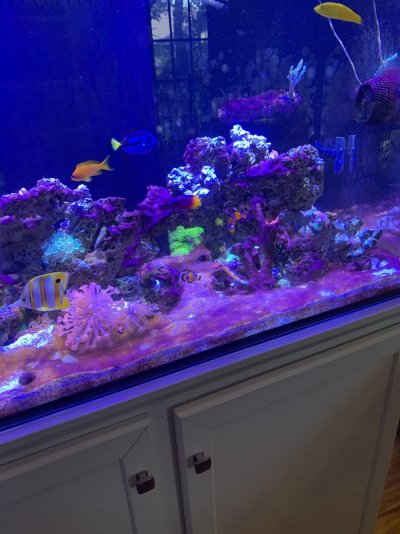vetteguy53081
Well known Member and monster tank lover
View Badges
Partner Member 2024
Excellence Award
Reef Tank 365
RGB
Article Contributor
Tampa Bay Reef Keepers
West Palm Beach Reefer
Hospitality Award
Ocala Reef Club Member
305 Reef Club
Wisco Reefers
Midwest Reefer
Fish Medic
MAC of SW Florida
Rock Pool Reef Keepers
R2R Secret Santa 2023
My Tank Thread
My Aquarium Showcase
Cyano blooms typically start when water nutrient concentrations go haywire. Just like when you eat too much sugar and your waistline starts to bloom, the same happens in your tank when concentrations of phosphate, nitrate and other organic compounds are too high.
Some of the most common causes include:
- Protein skimmer which fills water with tiny air bubbles. As bubbles form from the reaction chamber, dissolved organic compound molecules stick to them. Foam forms at the surface of the water and is then transferred to a collection cup, where it rests as skimmate
- Overstocking / overfeeding, your aquarium with nutrients is often the culprit of a cyano bloom
- Adding live rock that isn’t completely cured which acts like a breeding ground for red slime algae
- If you don’t change your water with enough frequency, you’ll soon have a brightly colored red slime algae bloom. Regular water changes dilute nutrients that feed cyanobacteria and keeps your tank beautifully clear
- Using a water source with nitrates or phosphates is like rolling out the welcome mat for cyano. Tap water is an example
- Inadequate water flow, or movement, is a leading cause of cyano blooms. Slow moving water combined with excess dissolved nutrients is a recipe for pervasive red slime algae development
I recommend to reduce white light intensity or even turn them off for 5-7 days. Add liquid bacteria daily for a week during the day at 1.5ml per 10 gallons. Add Hydrogen peroxide at night at 1ml per 10 gallons. Add a pouch of chemipure Elite which will balance phos and nitrate and keep them in check.
After the week, add a few snails such as cerith, margarita, astrea and nassarius plus 6-8 blue leg hermits to take control.
Some of the most common causes include:
- Protein skimmer which fills water with tiny air bubbles. As bubbles form from the reaction chamber, dissolved organic compound molecules stick to them. Foam forms at the surface of the water and is then transferred to a collection cup, where it rests as skimmate
- Overstocking / overfeeding, your aquarium with nutrients is often the culprit of a cyano bloom
- Adding live rock that isn’t completely cured which acts like a breeding ground for red slime algae
- If you don’t change your water with enough frequency, you’ll soon have a brightly colored red slime algae bloom. Regular water changes dilute nutrients that feed cyanobacteria and keeps your tank beautifully clear
- Using a water source with nitrates or phosphates is like rolling out the welcome mat for cyano. Tap water is an example
- Inadequate water flow, or movement, is a leading cause of cyano blooms. Slow moving water combined with excess dissolved nutrients is a recipe for pervasive red slime algae development
I recommend to reduce white light intensity or even turn them off for 5-7 days. Add liquid bacteria daily for a week during the day at 1.5ml per 10 gallons. Add Hydrogen peroxide at night at 1ml per 10 gallons. Add a pouch of chemipure Elite which will balance phos and nitrate and keep them in check.
After the week, add a few snails such as cerith, margarita, astrea and nassarius plus 6-8 blue leg hermits to take control.
















